高一英语必修三UNIT2教案
人教英语必修三Unit2全单元教案.doc
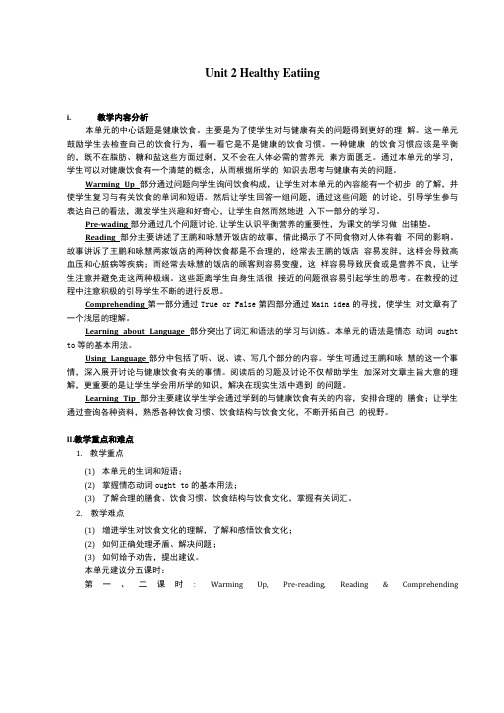
Unit 2 Healthy Eatiingi.教学内容分析本单元的中心话题是健康饮食。
主要是为了使学生对与健康有关的问题得到更好的理解。
这一单元鼓励学生去检查自己的饮食行为,看一看它是不是健康的饮食习惯。
一种健康的饮食习惯应该是平衡的,既不在脂肪、糖和盐这些方面过剩,又不会在人体必需的营养元素方面匮乏。
通过本单元的学习,学生可以对健康饮食有一个清楚的概念,从而根据所学的知识去思考与健康有关的问题。
Warming Up部分通过问题向学生询问饮食构成,让学生对本单元的內容能有一个初步的了解,并使学生复习与有关饮食的单词和短语。
然后让学生回答一组问题,通过这些问题的讨论,引导学生参与表达自己的看法,激发学生兴趣和好奇心,让学生自然而然地进入下一部分的学习。
Pre-wading部分通过几个问题讨论,让学生认识平衡营养的重要性,为课文的学习做出铺垫。
Reading部分主要讲述了王鹏和咏慧开饭店的故事,借此揭示了不同食物对人体有着不同的影响。
故事讲诉了王鹏和咏慧两家饭店的两种饮食都是不合理的,经常去王鹏的饭店容易发胖,这样会导致高血压和心脏病等疾病;而经常去咏慧的饭店的顾客则容易变瘦,这样容易导致厌食或是营养不良,让学生注意并避免走这两种极端。
这些距离学生自身生活很接近的问题很容易引起学生的思考。
在教授的过程中注意积极的引导学生不断的进行反思。
Comprehending第一部分通过True or False第四部分通过Main idea的寻找,使学生对文章有了一个浅层的理解。
Learning about Language部分突岀了词汇和语法的学习与训练。
本单元的语法是情态动词ought to等的基本用法。
Using Language部分中包括了听、说、读、写几个部分的内容。
学生可通过王鹏和咏慧的这一个事情,深入展开讨论与健康饮食有关的事情。
阅读后的习题及讨论不仅帮助学生加深对文章主旨大意的理解,更重要的是让学生学会用所学的知识,解决在现实生活中遇到的问题。
人教版高中英语必修三unit2教案 最终版演示教学

版
精品文档
Teaching Plan Unit2 Healthy Eating
教材
人教版高中英语必修三
试讲者
李瑶
单位
新疆师范大学
适用年级
高中一年级
单元Leabharlann 第二单元课题Come and Eat Here (Reading)
课时
共五课时,第二课 时
一.教材分析 Analysis of the Teaching Materials
收集于网络,如有侵权请联系管理员删除
精品文档
3.Emotion Objectives 1. Stimulate students understand the concept of healthy eating correctly, form good eating habits. 四. 教学重点、难点分析 Teaching Key and Difficult Points 1. Teaching Key Points 1. Learn to correctly use some of the key words and phrases of this unit. 2. Understand the role of various foods on the human body and improve the awareness of the formation of a healthy diet. 3. Use different reading strategies to understand and analyze the text. 2.Teaching Difficult Points 1. Use different reading strategies to understand and analyze the text. 2. Can express their own views and suggestions on the practical problems encountered around them. 五.教法、学法与教具 Teaching and Learning Methods and Aids 1.Teaching Methods
必修三unit2Reading and thinking教案

M3 Unit 2 Healthy LifestyleReading and ThinkingTeaching content:Habits for a healthy lifestyle 健康的生活方式需养成的习惯Teaching objectives:By the end of this period, students will be able to:1.discover the elements of the habit cycle and understand how the habit cycle works.2.explore the textual pattern and the writing skills of the text.3.build up the confidence and ability to develop good health habits.Analysis of teaching material:The theme of this section is "Learn to develop good health"habits). Much of what we do in our daily lives comes from the power of habit. Whether good habits or bad habits, their The power is amazing. Good habits can make people's work, life and study smoothly, bad habits will make people deeply hurt without knowing it. However, habits can be controlled and changed. By reading the texts, students can understand the harm of bad living habits, explore the causes of habit formation, understand the principle of habit cycle in psychology, and learn to apply this principle to change bad living habits and develop healthy living habits.Habit, but also for the future of a happy life to lay a solid foundation.Analysis of students:Help students to deepen the understanding of text information, improve the quality of students' thinking.Teaching key points:1.Lead students to develop good health habits using the habit cycle.2.Help students master the problem-solution pattern and the writing skills of the text. Teaching difficult points:1.Enable students to figure out the textual pattern.2.Lead students to understand how the habit cycle work.Teaching aids:PPT、textbook、blackboard、chalkTeaching method:Task based teaching methodTeaching procedures:Step I Lead-in Show some pictures to the students and ask them questions.1. What kind of lifestyle do you lead?2. Do you have any unhealthy and bad habits? What are they?3. Are bad habits easy to change? Why or why not?(设计意图:通过提问引导学生对“习惯与健康”进行思考,激活学生已有的知识和经验,激发学生的学习兴趣,使他们形成阅读期待,为后续的阅读活动做好铺垫。
人教版高中英语必修三unit2教案 最终版

1.KnowledgeObjectives
1.Get studentsto learn to use some of the key words and phrases of this unit .
2. Understand the role of various foods on the human body and candistinguish whichis a healthy diet, which is not.
2.Ability Objectives
1.Enable students toexpress their own views and suggestions on the practical problems encountered around them.
2. Can skim the text, find and process the relevant information in the text,according to the text content to answer some questions.
e different reading strategies to understand and analyze the text.
2.Teaching Difficult Points
e different reading strategies to understand and analyze the text.
This lesson is based on the reading partCome and Eat Hereof student textbooks which comes from the high school English compulsory book three unit twoHealthy Eating.The text mainly describes the competition between Wang Peng and Yong Hui, who are both operating restaurant,meanwhile,describes the so-called concept of healthy eating.Through the whole learning of the unit,students will understand the role of various foods on the human body,what’s more,teacher will also guide students to pay attention to a balanced diet and encourage students to develop healthy eating habits.
人教新课标高中英语必修三教案:Unit2+教案.doc

Unit2 Healthy eatingTeaching Aims of this unit1.Talk about healthy eating2.Making suggestions or giving advice on diet3.Distinguish the meanings of Modal verbs4.Make a balanced menu5.Vocabulary:6.fiber,digestion,bean,slim,curiosity,lie,debt,glare,limit,benefit,item,protectiveget rid of, throw away, get away with, tell lies, earn one’s living in debt ,set out run one’s business ,carry on7.Practice talking about your ideas; practice giving suggestions and advice,8.practice seeing the doctor.9. The use of ought toThe first period Warming up and readingStep Ⅰ Warming upReview the words of foods by showing their pictures. First, ask students to list the foods they like best. Then tick off 3 of them they eat most often. Second, show the three groups of foods and see which group their foods belong to. Third, ask the students to tell us in what ways their foods help them grow.Step Ⅱ Pre-readingGet the students to discuss the questions with their partners in this part. Then ask them to report their work. This part will help the students understand the text.T: Please look at the slide show and discuss the questions with your partners. Then I’ll ask you to report your work. Are you clear?Step Ⅲ ReadingGet the students to comprehend the passage quickly and accurately and meanwhile help the students to form a good habit of reading. Give the students a couple o f minutes to look through the whole passage. Tell the students to read the text silently and then ask for the main idea of the text on the slide show with their partners. Encourage the students to express their ideas.1.Fast readingIn this part ask the students to read the text quickly for the first time and find out the main idea of the text. Then ask them to read the text again carefully to obtain some details. Before reading show the tasks and let the students read the tasks first.This text will help them have a good understanding of the text.a.The two restaurants supplied the healthy diet.b.The reason why Yong Hui’s restaurant was so popular with customers.c.Wang Peng found out why he had lost his customers and decided to win them back2.Careful readingT: Now it is time for us to read the text carefully and decide which sentences are true. Then correct the false ones. First read the sentences.ually Wang Peng’s restaurant was full of people. (T )b.Yong Hui served a balanced diet. ( F)c.Yong Hui could make people thin in two weeks by giving them a good diet. (F)d.Wang Peng’s customers often became fat after eating in his restaurant. (T)e.Yong Hui’s menu gives them energy foods. (F )f.Wang Peng’s menu gives them foods containing fiber. (F )g.Wang Peng admired Yong Hui’s restaurant when he saw the menu. (F )h.Wang Peng decided to copy Yong Hui’s menu. (F )Step Ⅳ ComprehendingBy now, the students have had a further understanding of the text. Let the students read the text again and find out the differences between the two restaurant.T: Now please read the text again and fill in the chart together with your partner.T: Until now we have known what’s wrong with both restaurant. What does it matter if you only eat at one of the restaurant?S1:…S2:…S3:…T: You all have a point here. But what will they do? We will see it next period.Facing the serious competiton Wang wasn’t lost in sadness and he didn’t quarrel with his competitor either. He went to the library to learn more about healthy eating and made his menu better than Yong Hui’s menu. Do you think we should follow his example?Ss: Yes.T: Now let’s deal with some language points. Turn to page 10, let’s look at the sentences:a.Wang Peng sat in his empty restaurant feeling very frustrated.This sentence means that the second action “feeling very frustrated”happened together with the main action “sat”. Pay attention to the form (v-ing) of the second action.b. Nothing could have been better.This sentence tells us that everything has worked out the way you would like. It’s a sentence that we can use in any situation.c. He couldn’t have Yong Hui getting away with telling people lies!This sentence means that he will punish Yong Hui for her telling lies.1)lie : something untrueA white lie isn’t going to hurt anyone .2) say something which is not trueHe lied to his wife so that he could come home late .Step Ⅴ Homework1.Try to retell the text.2.Prepare for the language learning and do Using words and Expressions on WB (Page 49-50)The second period Language studyStep ⅠRevision1.Check the students’ homework.2.Ask some of the students to retell the text.Step Ⅱ Word studyThis part is a consolidation of the words in the text. Ask the students to do the exercise individually.T: Now please open your books and turn to page 12. Fill in the chart using the correct forms of the words which have the same root. Next activity is to match the definitions with the words we have learnt form the text. I necessary, you can discuss with yourpartners.…Step Ⅲ GrammarThe students will learn the usage of modal verbs. First try to make the students clear the functions of modal verbs, Then give them some examples.T: Please pick out all the sentences containing modal verbs in the text.a.By lunchtime they would have all be sold---It indicates possibility.b.His restaurant ought to be full of people. ---It indicates possibility.c.What could have happened?--- It indicates possibility.d.Nothing could have been better.--- It indicates possibility.e.Something terrible must have happened if Maochang was not coming to eat with him ashe always did.---It indicates guessing.f.He could not believe his eyes. ---It indicates intension.g.Perhaps he should go to the library to find out ---It indicates duty.h.He couldn’t have Yong Hui getting away with telling people lies!---It indicatesintension.…Step Ⅳ Homework1.Review the rules of word formation and the meanings of modal verbs.2.Prepare the Using Structure on page 50 by making a dialogue in pairs.The third period ListeningStep Ⅰ Revision1.Check the using structure on page 50.2.Ask the students to make a short dialogue in pairs.Step Ⅱ Listening ( using language)The purpose of this listening text is to familiarize the students with different kinds of food and the results of eating an unbalanced diet .This is a talk between Wang Peng and an expert about what makes a balancedDiet .Ask the students to finish the chart and answer the questions.T: OK. We have studied the text and know neither of the restaurant supplied a balanced diet. Let’s listen to the tape and see how the story went on. Go through the text quickly on page 14.( Play the tape. Students write down the answers and check the answers with their partners.)T: Now listen to it again and try to make sure your answers are right.Answer key for Exercise 2:Wang Peng is doing research to find out how an unbalanced diet can affect your health , so you need to eat a balanced diet a balanced diet if you are to stay healthy.Answer key for Exercise 3:Scurvy : not enough vitamin CRickets : not enough protein and vitamin DObesity : too much rice , noodles and sugarAnswer key for Exercise 4:Step Ⅲ Listening (WB P48)The students will heat a conversation between Emma and the doctor. They are asked to do exercise according to the tape.T: Doctor knows that there are illnesses you may get if you do not eat properly. In the following part, we are going to listen to a dialogue. Emma is going to see the doctor. Let’s see how the doctor gives her some advice. Listen carefully and do the exercises.Step Ⅳ Homework1.Pre-view the reading (2) and reading task on Page 52. See how the story ended.2.Find some information about healthy eating on the Internet.The fourth period Extensive readingStep ⅠRevision1.Check the homework2.Share the information the students have got form the Internet.Step Ⅱ Pre-readingAsk the students to read some proverbs and translate them into Chinese.T: Today we are going to see the end of the story. First, please look at the blackboard and try to translate the proverbs into Chinese.a.You are what you eat.b.An apple a day keeps the doctor away.c.First wealth is health.The students discuss with their partners.a.人如其食.b.一天一个苹果,医生不来找我.c.健康是人生的第一财富.Step Ⅲ ReadingThe purpose of this reading is to complete the story of Wang Peng and Yong Hui and show the students that it is never too late to change bad eating habits and begin afresh. After the fast reading, let the students do the exercises on page 14. Then let them match the words with their definitions.T: Eating healthily means that no food in itself is good or bad. Eating properly depends on eating the right variety of foods in the right amount. Let’s read the passage quickly and say what they did with their menu.Ask the students to report their work.Then find the words from the text to match the definitions.Step Ⅳ Homework1.Collect eating attitudes from the Internet2.Practice presenting reasons to support your ideas.The fifth period SpeakingStep ⅠRevisionCheck the students’ homework.Step Ⅱ Warming upT: Work in pairs to act out the dialogue on page 13. One plays as the role of Jane andthe other plays the role of Susan. You are shopping in a supermarket.First let the students make a good preparation themselves. Then ask several pairs to act out the dialogue before the class. In this part, try to make the class get active.Step Ⅲ TalkingIf young people are too thin or too fat, it shows that they are not eating a balanced diet. So this exercise is to encourage the students to discuss how their diets may affect their quality of life.( Divide the class into two groups: team A and team B.)T: Now team A will take the role o f the patient who is worried about being too fat and has gone to the doctor for advice. Team B will take the role of the doctor and advise the patient how to change his or her diet. Here are some useful expressions. Imagine what you will say to the doctor or patient. Discuss with your group members.Step Ⅳ Speaking taskThis is the opportunity for the students to discuss their reaction to the information they have received. It allows students to have their own point of view and to practice explaining why they think as they do.T: In the reading task we have read two speakers’ arguments. Now it is your turn to discuss what you have heard at the meeting in groups of four. The following is useful to you. Please look at the table.Step Ⅴ Homework1.Review the sentence structures, new words and expressions.2.Imagine the old local restaurant has gone. What do you think should be built there.Present the advantages of your idea.The sixth period WritingStep ⅠRevisionCheck the homework and take a dictation.Step Ⅱ WritingThis is an opportunity for students to practice their persuasive writing skills and try to encourage others to support their point of view. The idea of a new restaurant is chosen because it would be very useful in a town.Your writing should :Explain what kind of food will be offered in your restaurantDescribe their ingredients ,flavour ,smell and appearanceExplain how they will provide a balanced dietExplain why your restaurant will provide the best food in the areaExplain how customers will be served精美句子1、善思则能“从无字句处读书”。
高一英语(人教版)-必修三教案: Unit 2 Morals And Virtues
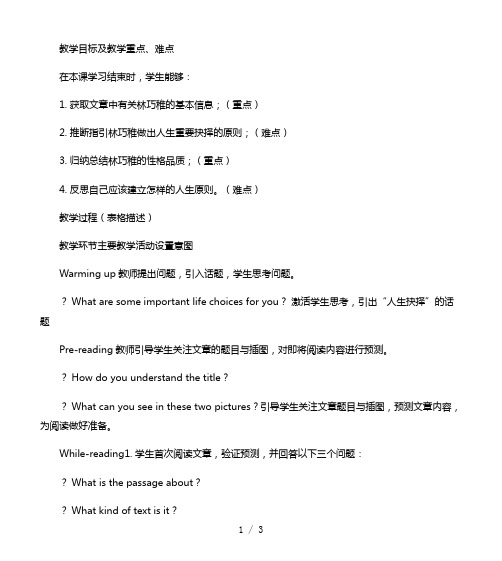
教学目标及教学重点、难点在本课学习结束时,学生能够:1. 获取文章中有关林巧稚的基本信息;(重点)2. 推断指引林巧稚做出人生重要抉择的原则;(难点)3. 归纳总结林巧稚的性格品质;(重点)4. 反思自己应该建立怎样的人生原则。
(难点)教学过程(表格描述)教学环节主要教学活动设置意图Warming up教师提出问题,引入话题,学生思考问题。
? What are some important life choices for you?激活学生思考,引出“人生抉择”的话题Pre-reading教师引导学生关注文章的题目与插图,对即将阅读内容进行预测。
? How do you understand the title?? What can you see in these two pictures?引导学生关注文章题目与插图,预测文章内容,为阅读做好准备。
While-reading1. 学生首次阅读文章,验证预测,并回答以下三个问题:? What is the passage about?? What kind of text is it?? How are the events in the passage arranged?引导学生通过关注文章类型及写作手法,以获取文章主旨。
2. 学生再次阅读文章,梳理林巧稚故事的时间轴。
3. 学生根据时间轴,整理关于林巧稚人生中的重大事件,并填写表格。
? Read the passage again more carefully and take notes of all the important events happened to Lin Qiaozhi.4. 引导学生关注所整理信息中的林巧稚的重大人生抉择,并思考她为此做出了哪些牺牲。
? What hard choices was she faced with throughout her life? Underline the sentences.? What did she sacrifice for those choices?? What does the author want to illustrate b y mentioning Dr. Lin’s life choices?引导学生通过获取文章中有关林巧稚重大人生抉择的事实性信息,推断出她做出了哪些牺牲。
外研版高一英语必修第三册(2019版)_Unit_2_单元教学设计

T plays a video clipand encouragesSsto answer the following questions:
1.How much do you know about Charity Day in China?
2.How much do you know about Put It Forward Day?
3.Open.Ssare encouraged to useproperwords that describe personal qualities.
Ssare expected to recall the words which describe personal qualities.
Ssare expected toapplytheir vocabulary about personal qualities.
2.通过完成教材13页活动2,学生能够通过阅读图片中人物的quotation,说出其所做的贡献,运用恰当的词汇描述人物品质,并能联系所学知识举出更多的人物事例,以加深对描述人物品质的词汇的理解。
教学重点
1.学生了解并能说出我国CharityDay和西方Put It Forward Day的基本情况,能够认识到“Donatingmoneyisnottheonly way to help others.”和“Onesmallactcanmakeabigdifference.”。
该语篇以时间线索展开,通过第一段“问题的提出”,第二段到第五段“问题的解决”和第六段“解决问题的意义”逐层推进。特别是第二段到第五段,一波三折,很好地体现了Ryan从事公益事业的三个阶段,即work hard alone to reach his first target of $70到ask for help from his classmates andneighboursto raise $2000 with the help of his mother’s friend到set up a foundation to encourage more people to help,体现了Ryan坚定地从事志愿活动,为实现自己的梦想持之以恒的努力。活动1是看图并谈论非洲国家淡水资源匮乏的问题,通过勾选为非洲提供淡水的举措,启动学生思考如何帮助非洲部分区域解决淡水问题,引导学生进入对于阅读语篇主题意义的探究。活动2是通过阅读理解课文的主要事实。活动3是通过阅读准确理解课文标题意义,要求学生对于自己的理解进行合理解释。活动4提供了四幅图片勾勒出Ryan从事公益事业的起因及经历,并通过补全句子帮助学生梳理记叙文的六要素,特别是事件的起因、经过和结果,有助于学生熟悉记叙文的语篇结构。
英语必修三unit2 教案
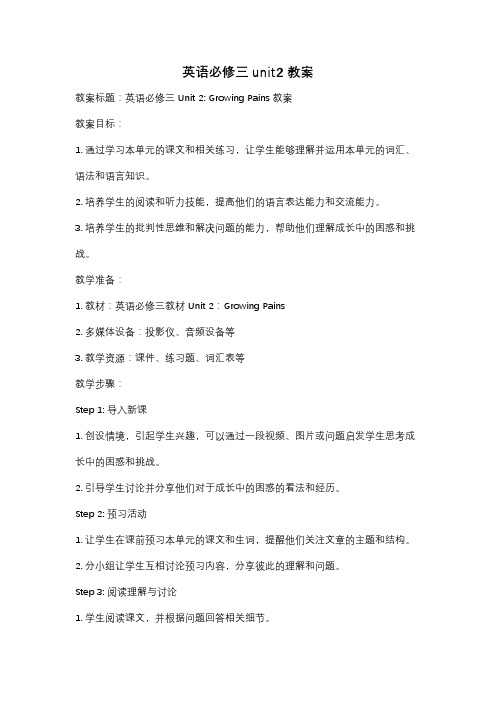
英语必修三unit2 教案教案标题:英语必修三 Unit 2: Growing Pains 教案教案目标:1. 通过学习本单元的课文和相关练习,让学生能够理解并运用本单元的词汇、语法和语言知识。
2. 培养学生的阅读和听力技能,提高他们的语言表达能力和交流能力。
3. 培养学生的批判性思维和解决问题的能力,帮助他们理解成长中的困惑和挑战。
教学准备:1. 教材:英语必修三教材 Unit 2:Growing Pains2. 多媒体设备:投影仪、音频设备等3. 教学资源:课件、练习题、词汇表等教学步骤:Step 1: 导入新课1. 创设情境,引起学生兴趣,可以通过一段视频、图片或问题启发学生思考成长中的困惑和挑战。
2. 引导学生讨论并分享他们对于成长中的困惑的看法和经历。
Step 2: 预习活动1. 让学生在课前预习本单元的课文和生词,提醒他们关注文章的主题和结构。
2. 分小组让学生互相讨论预习内容,分享彼此的理解和问题。
Step 3: 阅读理解与讨论1. 学生阅读课文,并根据问题回答相关细节。
2. 分组讨论学生对于课文中的主题、观点和故事的理解和感受。
3. 教师引导学生进行全班讨论,鼓励学生提出自己的观点和见解。
Step 4: 语言知识探究1. 教师引导学生注意课文中的语法结构和词汇,解释并澄清学生的疑惑。
2. 教师通过示例和练习,帮助学生巩固和运用所学的语言知识。
Step 5: 听力训练1. 播放与课文相关的听力材料,要求学生根据听到的内容回答问题。
2. 分组讨论学生对听力材料的理解和感受,教师引导学生进行全班讨论。
Step 6: 听力与口语练习1. 将学生分成小组进行角色扮演,模拟对话和情景,以提高学生的口语表达能力。
2. 教师在小组活动过程中给予学生指导和反馈,帮助他们改进口语表达。
Step 7: 语言输出活动1. 让学生根据课文内容,写一篇关于成长中的困惑和挑战的短文。
2. 学生可以结合自己的经历和观点,展示对于成长中困惑的理解和解决方法。
高一英语人教版必修三Unit2MoralsAndVirtues61教案
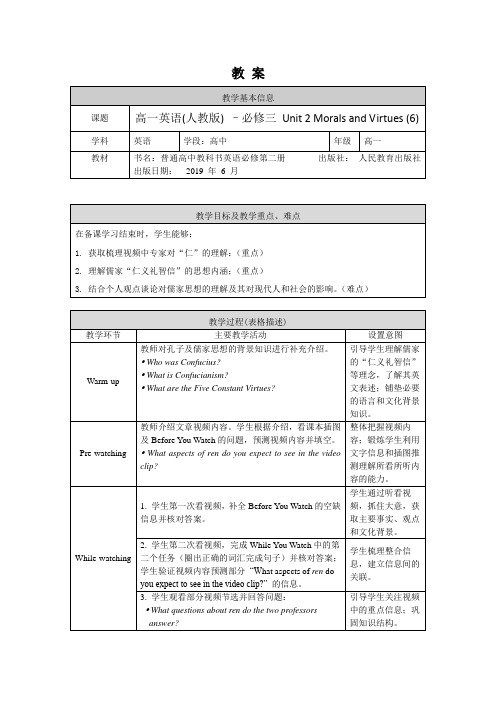
学生结合个人理解探讨如下问题:
In what ways do you think Confucian thought still influences education and society in China?
Do you think that your life would change if you understood and practised ren every day?
2.理解儒家“仁义礼智信”的思想内涵;(重点)
3.结合个人观点谈论对儒家思想的理解及其对现代人和社会的影响。(难点)
教学过程(表格描述)
教学环节
主要教学活动
设置意图
Warm-up
教师对孔子及儒家思想的背景知识进行补充介绍。
WhowasConfucius?
What is Confucianism?
What are the Five Constant Virtues?
Where does ren come from?
Is there one single concept that we can take as a guide for all actions in our lives?
强化语言知识和文化知识的内化;启发学生深入思考视频信息,为后续语言活动实践做铺垫。
教 案
教学基本信息
课题
高一英语(人教版)–必修三Unit2Morals and Virtues(6)
学科
英语
学段:高中
年级
高一
教材
书名:普通高中教科书英语必修第二册出版社:人民教育出版社出版日期:2019年6月
教学目标及教学重点、难点
在备课学习结束时,学生能够:
高一英语必修三Unit2教案
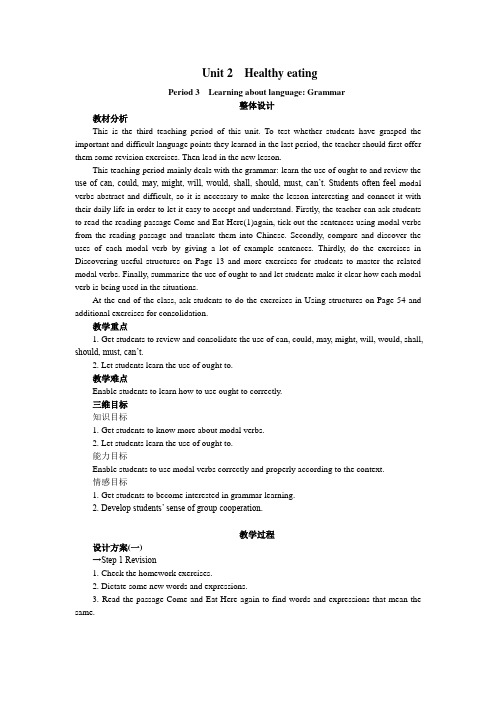
Unit 2Healthy eatingPeriod 3Learning about language: Grammar整体设计教材分析This is the third teaching period of this unit. To test whether students have grasped the important and difficult language points they learned in the last period, the teacher should first offer them some revision exercises. Then lead in the new lesson.This teaching period mainly deals with the grammar: learn the use of ought to and review the use of can, could, may, might, will, would, shall, should, must, can’t. Students often feel modal verbs abstract and difficult, so it is necessary to make the lesson interesting and connect it with their daily life in order to let it easy to accept and understand. Firstly, the teacher can ask students to read the reading passage Come and Eat Here(1)again, tick out the sentences using modal verbs from the reading passage and translate them into Chinese. Secondly, compare and discover the uses of each modal verb by giving a lot of example sentences. Thirdly, do the exercises in Discovering useful structures on Page 13 and more exercises for students to master the related modal verbs. Finally, summarize the use of ought to and let students make it clear how each modal verb is being used in the situations.At the end of the class, ask students to do the exercises in Using structures on Page 54 and additional exercises for consolidation.教学重点1. Get students to review and consolidate the use of can, could, may, might, will, would, shall, should, must, can’t.2. Let students learn the use of ought to.教学难点Enable students to learn how to use ought to correctly.三维目标知识目标1. Get students to know more about modal verbs.2. Let students learn the use of ought to.能力目标Enable students to use modal verbs correctly and properly according to the context.情感目标1. Get students to become interested in grammar learning.2. Develop students’ sense of group cooperation.教学过程设计方案(一)→Step 1 Revision1. Check the homework exercises.2. Dictate some new words and expressions.3. Read the passage Come and Eat Here again to find words and expressions that mean the same.Alternative words and expressions Words and expressions from the text shouldrun away after doing something wrongsomething to make you thin by eating itwish to know about somethingget rid of somethingAlternative words and expressionsparts of plants that help food move quickly throughthe bodychanging food into something the body can useproper amount of different kinds of food needed forgood healthGive students about four minutes to find the suitable words and expressions. Then check the answers with the whole class.Suggested answers:Alternative words and expressions Words and expressions from the textshould ought torun away after doing something wrong get away withsomething to make you thin by eating it slimming foodswish to know about something curiosityget rid of something throw awayAlternative words and expressions Words and expressions from the textfibreparts of plants that help food move quicklythrough the bodychanging food into something the body can use digestionbalanced dietproper amount of different kinds of foodneeded for good health→Step 2 Leading-in by revisionTranslate the following sentences and explain how each of these modal verbs is being used in the situations.1. He could hardly support his family before he found the new job.2. Where could/can the boy be now?3. May/Might I come in?4. You may/might catch sight of the sunrise from here when you get up before 5 in the morning.5. You mus t hurry up or you’ll be late.6. Whatever you want, you shall have.7. We should read English aloud every morning.8. He would sit there for hours, doing nothing at all.Suggested answers:1. 他在找到那份新工作前几乎无法养家糊口。
高一英语必修3Unit2教案
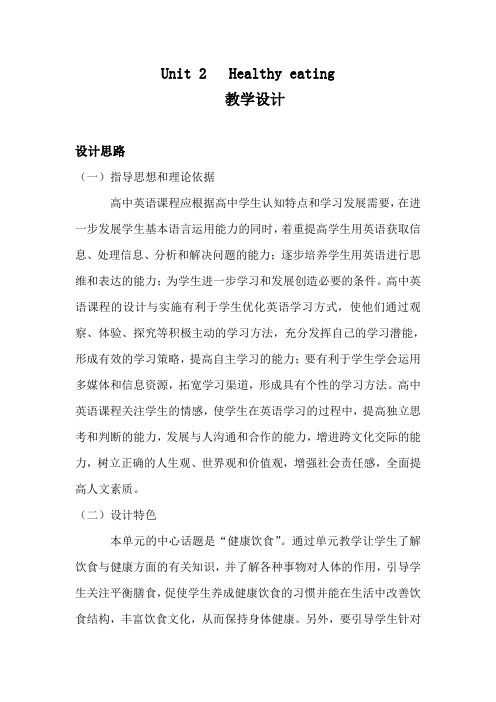
Unit 2 Healthy eating教学设计设计思路(一)指导思想和理论依据高中英语课程应根据高中学生认知特点和学习发展需要,在进一步发展学生基本语言运用能力的同时,着重提高学生用英语获取信息、处理信息、分析和解决问题的能力;逐步培养学生用英语进行思维和表达的能力;为学生进一步学习和发展创造必要的条件。
高中英语课程的设计与实施有利于学生优化英语学习方式,使他们通过观察、体验、探究等积极主动的学习方法,充分发挥自己的学习潜能,形成有效的学习策略,提高自主学习的能力;要有利于学生学会运用多媒体和信息资源,拓宽学习渠道,形成具有个性的学习方法。
高中英语课程关注学生的情感,使学生在英语学习的过程中,提高独立思考和判断的能力,发展与人沟通和合作的能力,增进跨文化交际的能力,树立正确的人生观、世界观和价值观,增强社会责任感,全面提高人文素质。
(二)设计特色本单元的中心话题是“健康饮食”。
通过单元教学让学生了解饮食与健康方面的有关知识,并了解各种事物对人体的作用,引导学生关注平衡膳食,促使学生养成健康饮食的习惯并能在生活中改善饮食结构,丰富饮食文化,从而保持身体健康。
另外,要引导学生针对现实中遇到的实际问题发表自己的看法。
通过合作式、探究式学习方式,激发学生的学习兴趣,使学生由被动变主动,积极参与学习过程。
教材分析(一)教材处理在本节阅读课前,先进行词汇教学,然后围绕中心话题Healthy Eating 复习与学生的生活实际息息相关的食物,然后向本单元词汇过渡。
在阅读过程中,笔者根据学生认知特点和实际情况,把教材中的Warming up作为Reading的导入部分,把Pre-reading,Reading和Comprehending整合在一起作为一堂“精读课”。
(二)教学目标(1)熟悉有关食品的各种词汇,对比中餐和西餐的区别。
根据不同食品对人身体的不同影响,使学生对合理饮食、饮食习惯、饮食结构与饮食文化有更深入地了解,倡导健康饮食。
最新高一英语必修三UNIT2教案说课材料
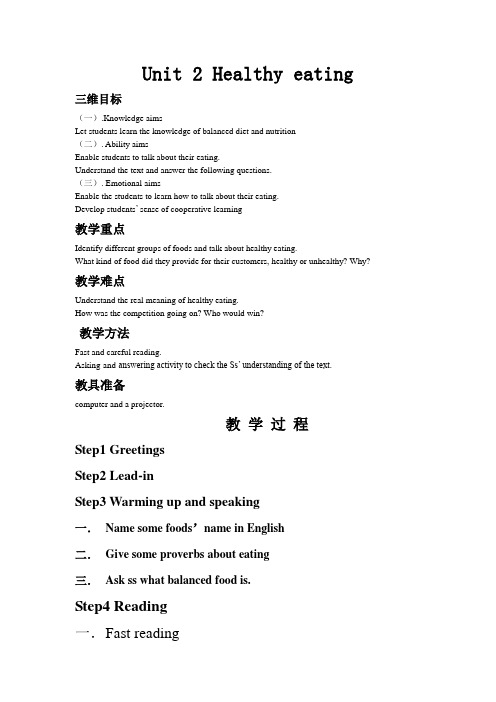
Unit 2 Healthy eating 三维目标(一).Knowledge aimsLet students learn the knowledge of balanced diet and nutrition(二). Ability aimsEnable students to talk about their eating.Understand the text and answer the following questions.(三). Emotional aimsEnable the students to learn how to talk about their eating.Develop students’ sense of cooperative learning教学重点Identify different groups of foods and talk about healthy eating.What kind of food did they provide for their customers, healthy or unhealthy? Why? 教学难点Understand the real meaning of healthy eating.How was the competition going on? Who would win?教学方法Fast and careful reading.Asking-and-answering activity to check the Ss’ understanding of the text.教具准备computer and a projector.教学过程Step1 GreetingsStep2 Lead-inStep3 Warming up and speaking一.Name some foods’name in English二.Give some proverbs about eating三.Ask ss what balanced food is.Step4 Reading一.F ast reading1.True or falseTrue or FalseTFTFFF 2.Fill in the blanks二.I ntensive readingC h o o s e t h e b e s t a n s w e r1When Wang Peng thought “Nothing could be better”, he means _______A. His food and drinks were the best.B. His food and drinks were the worst.C. His food should have been improved.D. He could do nothing with his food and drinks.2. Why did Wang Peng go into the newly-opened restaurant?A. Because he was angry.B. Because he was curious.C. Because he wanted to blame its owner.D. Because he wanted to ask for advice.3. What is Wang Peng’s impression on Yong Hui’s restaurant?A. All the customers in it were very slim.B. It was too small and too noisy.C. The food in it was very nice and better than that inhis.D. There was so limited food but the price was muchhigher.Step5 Discussion Step6 Homework 护理评估1. 病史评估起病情况:如起病的时间、方式、有无明显的前, 驱症状和伴发症状。
高中:高一英语必修三unit2 Healthy eating导教案(参考文本)
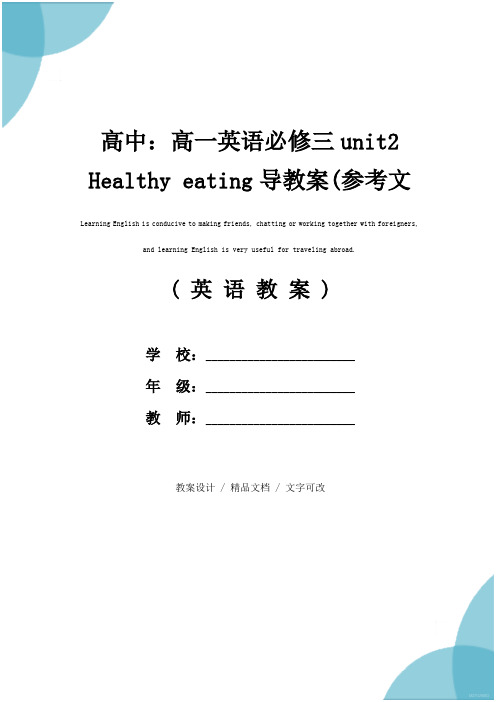
( 英语教案 )学校:_________________________年级:_________________________教师:_________________________教案设计 / 精品文档 / 文字可改高中:高一英语必修三unit2 Healthy eating导教案(参考文Learning English is conducive to making friends, chatting or working together with foreigners, and learning English is very useful for traveling abroad.高中:高一英语必修三unit2 Healthy eating导教案(参考文本)导学案3 come and eat here (2)learning about language and using language( come and eat hereⅱ)ⅰ.read the passage and tell the following statements true or false.1. wang peng’s smile left him because he felt ill.( ) 2. young hui came to wang peng’s restaurant in order to spy on him.( ) 3. young hui stayed in wang peng’s restaurant and enjoyed dumplings and breast of chicken.( ) 4. wang peng put on more weight and young hui became thinner.( ) 5. wang peng and young hui quarrelled in the end.( ) ⅱ.language points. choose the best answer. 1.consult sb about sth 向某人咨询某事 consult(with)sb (about /on sth) (就某事)与某人商量2.limit sb/sth 限制某人或某物limit sb/sth (to sth) 给某人/某事定界限within limits 适度地;有限度地without limit 无限地 limited 有限的3.for sb’s benefit 为帮助某人,为某人的利益for the benefit of 为了……;为……的利益be of benefit to 对……有益beneficial adj.有利的;有益的;受益的be beneficial to 对……有益;对……有利bine……with……把……和……结合起来6. earn one’s living (by) 靠……谋生= make a/one’s living 靠……谋生7.in debt 欠债;欠账pay off one’s debt 还清债务be out of debt 不欠债get out of debt 还清债务go/run/get into debt 负债8.after all(句首)毕竟;要知道(句尾)虽然……,但终究9.cut down削减;砍倒;缩短某物1.____the timetable to see when the last train leaves.a.seeb.watchc.lookd.consult 2.the policeman asked the driver to ___ his speed to below 40 miles an hour. a.make b.give c.limit d.explain 3.we do morning exercises every day,from which we _____a lot. a.strength b.gain c.award d.benefit 4.if your knowledge can be in some way____with my experience,we are sure to succeed. a.joined b.connected c.united bined 5.the poor child has to earn his_____by ____newspapers every day. a.living;sell b.live;selling c.living;sold d.living;selling 6.why are you so anxious?it isn’t your problem____. a.on purpose b.in all c.on time d.after all 7.your article is too long.your must____ to about 3000 words. a.cutit off b.cut it up c. cut it down d.cut it out 8.edward,you play so well.but i____you played the piano. a.didn’t know b. hadn’t known c.don’t know d.haven’t known 9.it is a wonderful play and i want to see it ___second time. a.the b.a c.this d.that 10.—how about _____christmas evening party? —i should say it was____success. a.a; a b.the; a c.a;∕ d.the; ∕ translation. 1.你就此事咨询过你的律师吗?_________? 2.你查过字典吗? _______? 3.以前他穷的时候欠了债,但自从富了以后就不欠债了。
高一英语必修3 Unit 2 Language 教案

高一英语必修3 Unit 2 LanguagePeriod 3 Word powerThe general idea of this periodIn this period we’ll deal with words and expressions related to language and enlarge students’vocabulary by distinguishing formal English from informal English and by learning countries and their languages.Teaching Aims:1.Enlarge the students’ vocabulary.2.Get the students to know about formal and informal English; and know somethingabout countries and their official languages.3.Through the listening practice, help the students know more how to improve theirEnglish.Teaching important points:1.Make the students know something about Formal and Informal English.2.Master the words in this part and use them freely.Teaching difficult points:How to make the students use this skill freely to solve some problemsTeaching methods:1.Talking to improve the students’ speaking ability.2.Practice to get the students to master what they’ve learnt.3.Discussion to make every student work in class.Teaching aids:1.the multimedia2.the blackboard.Teaching procedures:Step 1.. Revision and lead inSelect some words and phrases often used in spoken English, then point out informal English expressions① An informal letter:Dear Mr. Lee,I am so sorry that I cannot e to the dinner you and Mrs. Lee are giving next Saturday for your brother because of a previous engagement that evening.I do appreciate your asking me and hope that I will have the opportunity to meet your brother on some other occasion in the near future.② To judge which is the better expression:1.(To a professor you first meet)□----- Hi,Bob.Fancy meeting you here. (Too familiar and informal. ) □----- Good morning ,Mr.Mosley.How are you?2. (To a close friend)□----- Mr. Wells,would you be kind enough to pass me the salt? (There is no needto be so formal.)□----- Could you possibly pass me the salt? (There is no needto be so formal.)□----- Pass me the salt,Jack.③Read the following sentence and find which part you think is informal.I am sorry to say that a lot of your answers to those questions in your homework are not precise, so you must think about them.Then ask students to present some other examples.Formal and informal EnglishStep 2. Presentation1.Ask students to read the introductions to formal and informalEnglish .Formal English is more mon in writing, while informal Englishis more mon in speaking.2.Ask students to the formal English words with the informal English wordslisted in the chart on page 26.Step 3 PracticeAsk students to practice what they have learnt above.First point out the informal places while they are reading the letter.Then rewrite the letter in formal English.Answers:Dear Mr. Smith,I want to speak to you about the condition of the playground. I regret to inform you that people do not discard their rubbish properly. They leave rubbish on the ground instead of using the bins. Yesterday a 6-year-old child fell and cut his hand on a broken bottle. The boy was taken to hospitalimmediately. In addition, the beautiful view of the park is spoiled.I believe that there are a large number of actions you could take to solve this problem. For example, you should purchase additional litter bins and a rrange security to prevent people from littering.It is my hope that you will take my concerns into consideration. I look forward to your reply.Yours sincerely, Jerry BrokerStep 4 Word power ( Group work )1. How many languages are spoken in the world today?( About 6,ooo)2. Do you know the ten most widely spoken languages? What are they?( They are Chinese, English, Hindi, Spanish, Russian, Arabic, Bengali, Portuguese, Malay and French..)①. Organize students into groups of four and provide each group with a word map. Have each group write down as many names of countries and their official languages as possible.Use the following diagram as a pattern to organize the information.②. Then have students finish Part A and share their answers with their group members.③.Ask students to fill in the blanks of the following diagram about country, official language(s), people and capital, this help students enlarge their vocabulary.④. Discussion (Groups or pairs):What do you think the official languages of the United Nations are?Some resources about United Nations:http:/. un. org/EnglishStep 7 Listening practiceAsk students to do the exercises in Parts A and B in listening on page 98 in their Workbook. Let them know more about how to improve their English.Step 8. Summary and homeworkWe’ve known something about formal and informal English, deal with some words and expressions related to languages, and go over the names of countries and their language(s).Use these skills to enlarge or reinforce your vocabulary and try your best to improve your English.Homework:1.Go over what we learned in this period.2.Preview the next lesson3.To get more information about UN, according to the website given to you .( http:/. un. org/English )。
- 1、下载文档前请自行甄别文档内容的完整性,平台不提供额外的编辑、内容补充、找答案等附加服务。
- 2、"仅部分预览"的文档,不可在线预览部分如存在完整性等问题,可反馈申请退款(可完整预览的文档不适用该条件!)。
- 3、如文档侵犯您的权益,请联系客服反馈,我们会尽快为您处理(人工客服工作时间:9:00-18:30)。
Unit 2 Healthy eating 三维目标
(一).Knowledge aims
Let students learn the knowledge of balanced diet and nutrition
(二). Ability aims
Enable students to talk about their eating.
Understand the text and answer the following questions.
(三). Emotional aims
Enable the students to learn how to talk about their eating.
Develop students’ sense of cooperative learning
教学重点
Identify different groups of foods and talk about healthy eating.
What kind of food did they provide for their customers, healthy or unhealthy? Why?教学难点
Understand the real meaning of healthy eating.
How was the competition going on? Who would win?
教学方法
Fast and careful reading.
Asking-and-answering activity to check the Ss’ understanding of the text.
教具准备
computer and a projector.
教学过程
Step1 Greetings
Step2 Lead-in
Step3 Warming up and speaking
一.Name some food s’name in English
二.Give some proverbs about eating
三.Ask ss what balanced food is.
Step4 Reading
一.F ast reading
1.True or false
True or False
T
F
T
F
F
F 2.Fill in the blanks
二.I ntensive reading
C h o o s e t h e b e s t a n s w e r
1When Wang Peng thought “Nothing could be better”, he means _______
A. His food and drinks were the best.
B. His food and drinks were the worst.
C. His food should have been improved.
D. He could do nothing with his food and drinks.
2. Why did Wang Peng go into the newly-opened restaurant?
A. Because he was angry.
B. Because he was curious.
C. Because he wanted to blame its owner.
D. Because he wanted to ask for advice.
3. What is Wang Peng’s impression on Yong Hui’s restaurant?
A. All the customers in it were very slim.
B. It was too small and too noisy.
C. The food in it was very nice and better than that in
his.
D. There was so limited food but the price was much
higher.
Step5 Discussion Step6 Homework
The passage can be divided into 3 parts. Give the main idea of
each part .
Wang Peng was
________because his restaurant is not as _____as usual. He followed his friend to a newly opened _________ which was very ________.
Feeling worried, he did some ________to win his __________back.
worried
full
restaurant popular
research
customers。
